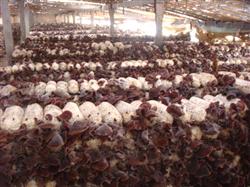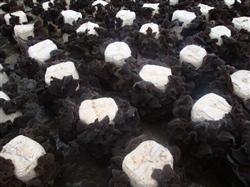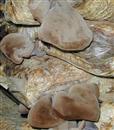How to control black fungus pests?

After the fungus bag, strain bottle, inoculation hole and fruiting body were infected by green mold, the white and slender hyphae grew on the wood or fruiting body in the initial stage, and after a few days, conidia could be formed. once a large number of conidia are formed or mature, the colony becomes green and powdery. Prevention and treatment 1. Keep the ear field, ear room and its surrounding environment clean and hygienic. 2. The ear room and ear field must be well ventilated and drained conveniently. 3. Spray 1% lime water every three days after ear out, which has a good anti-mildew effect. 4. If the green mold occurs on the surface of the culture material and has not gone deep into the material, the growth of the green mold can be controlled by scrubbing the affected area with the lime water of PH10. Symptoms of rotten ear (also known as flowing ear) after the ear piece matures, the ear piece becomes soft, and even the ear root dissolves and rot. Prevention and control 1, in view of the above causes of rotten ears to strengthen cultivation management, pay attention to ventilation, lighting and so on. 2. Harvest in time, the ear piece is close to maturity or has matured immediately. 3. Chlortetracycline or oxytetracycline solution of 25mg/kg can be sprayed to prevent ear flow. The cause of fungus prevention and mold pollution is an important reason to reduce the production of fungus and affect the product quality. Penicillium and Trichoderma are the most common miscellaneous bacteria on fungus. Anti-mildew measures 1. Select the strains with strong anti-mildew ability. 2. Choose fresh raw materials to spend the summer. 3. Adding anti-mildew agent to the culture material, at present, it is considered that the more effective method is to use 0.1% potassium permanganate aqueous solution, or to mix the material with lime water, which can also prevent the culture material from being too acidic. 4. Press the full bottle of bacteria and dig the bottle. The briquetting appliances and films should be sterilized with 0.1% potassium permanganate solution. Within 1 week after pressing, the hyphae have not fully recovered. If there is mold, the affected area can be smeared with saturated lime water. 5. During the period of environmental cleaning and mushroom production, after the first batch of fungus is harvested, spray 1% lime water on the ground every 3-5 days, or 1% color 2% coal phenol soap solution, or 0.1% carbendazim, or cross-use to control the growth of miscellaneous bacteria. 6. Indoor fungus and outdoor ear are considered to be an effective anti-mildew measure for Auricularia auricula cultivation. 7. Water management should be strengthened according to water loss and air flow rate of bacteria. Thrips are harmful to Auricularia auricula from larvae. After invading the ear piece, suck the juice, make the ear piece atrophy, cause the ear to flow seriously. 50-1000 times 40% dimethoate emulsion is used for prevention and treatment. 1000-1500 times 50% wettable trichlorfon solution and 1500 times malathion spray. The pseudo-walker is a harmful adult that eats the outer layer of the ear slice, and the larva harms the ear root, or drills into the inoculation hole to feed on the ear bud, and the injured ear root no longer forms ears. Dry ears stored in the reservoir can still be harmed after regaining moisture. The control method can remove the dead branches and leaves from the cultivation site and spray 200 times of dichlorvos solution to kill latent pests. When a large number of insect pests occur, the ear slices are removed first, and then sprayed with 1000-1500 times of dichlorvos; it can also be controlled with 500,800 times of rotenin, 500,800 times of pyrethrum emulsion, 1500 times of malathion, and 1000-2000 times of 50% wettable trichlorfon solution. During the period of Grain in Beard and the End of Heat, the above drugs can be sprayed once after each ear pick.
- Prev

How to cultivate auricularia auricula
First, an overview of black fungus, also known as fungus, light fungus, cloud ear. Classified into basidiomycetes, Tremella, Auriculaceae, Auricularia. There are more than ten species in this genus, such as Auricularia auricula. Auricularia auricula, horny fungus, shield-shaped fungus and so on. Only Auricularia auricula is rich and tender in texture and delicious in taste.
- Next

Auricularia auricula inoculation technique
There are many raw materials suitable for bag cultivation of Auricularia auricula, such as sawdust, cottonseed hull, broken seed cotton, bagasse, mulberry branches, mulberry stalks, straw, soybean stalks, peanut vines and so on. Except for sawdust, cottonseed hull, broken seed cotton and bagasse, the other raw materials should be crushed before they can be used in production. The technological process of bag cultivation of Auricularia auricula and Flammulina velutipes bag.
Related
- Fuxing push coffee new agricultural production and marketing class: lack of small-scale processing plants
- Jujube rice field leisure farm deep ploughing Yilan for five years to create a space for organic food and play
- Nongyu Farm-A trial of organic papaya for brave women with advanced technology
- Four points for attention in the prevention and control of diseases and insect pests of edible fungi
- How to add nutrient solution to Edible Fungi
- Is there any good way to control edible fungus mites?
- Open Inoculation Technology of Edible Fungi
- Is there any clever way to use fertilizer for edible fungus in winter?
- What agents are used to kill the pathogens of edible fungi in the mushroom shed?
- Rapid drying of Edible Fungi

